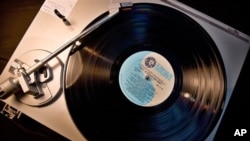JUNE SIMMS: Welcome to AMERICAN MOSAIC in VOA Special English.
(MUSIC)
I’m June Simms. This week on our program, we play some music from hit records on Billboard Magazine’s Top 200 Albums Chart.
We also read from our new blog, Confessions of an English Learner.
But first we go to a fair near Washington, DC, that celebrates an old form of music recordings.
(MUSIC)
DC Record Fair
JUNE SIMMS: When Americans buy music today, it is usually in the form of MP3s or CDs. But years ago, record albums were made on black circles made of the plastic material called vinyl. Christopher Cruise tells about a recent event near Washington that celebrated the vinyl recording media of the past.
CHRISTOPHER CRUISE: Until about thirty years ago, record albums were made of pressed vinyl about thirty centimeters across. They were not nearly as transportable as today’s recordings. And you needed a large turntable device on which to play the records.
In the nineteen eighties, cassette tape recordings began to outsell vinyl records. Cassettes were smaller and easier to carry around. They could be played on smaller devices as well.
Then, a few years later, music CDs were developed for mass market. Even later came the MP3. By this time most music lovers had stored or thrown away their vinyl albums.
But vinyl records are now making something of a comeback. Their biggest fans can be found among young people. There were many of them at a recent DC Record Fair held in Silver Spring, Maryland.
Tens of thousands of vinyl recordings were on sale at the Record Fair. And, hundreds of people were waiting to buy.
Chenae Brown is a nineteen-year-old college student. She bought ten albums for about twenty dollars at the fair. She told us she did not even have a turntable for playing them.
CHENAE BROWN: “I like the idea of buying something older. You know, instead of just going on iTunes and buying it. I like this, it’s exciting to find records that, you know, came out twenty years ago and you can buy it for two dollars.”
Tim Harris is among about forty sellers at the DC Record Fair. Mr. Harris worked for a reggae music record label for fifteen years. After it closed, he began selling used records to make a living.
He says he loves the element of surprise connected to the used records market.
TIM HARRIS: “The randomness and the, ah, you know the fact there’s a lot of obscure things you were never gonna be able to find on a CD that you could find on vinyl. And it just led to people trying to investigate and actually listen to stuff so instead of being sort of, ah, force-fed things through radio or by the major labels on CD it was more of an organic process of discovery of things from the fifties or the sixties or the seventies.”
Chenae Brown agrees.
CHENAE BROWN: “Yes, I bought a couple of albums today that I wasn’t expecting to buy, but they were, they called to me. You know, you just, you see an album, and you’re like ‘I really need that album,’ and so you buy it.”
Forty-five-year-old Jon Meyers has worked in the music industry for years. He started his career as an employee at a record store just as vinyl recordings were falling from favor.
He began to help organize vinyl record fairs in the Washington, DC, area about three years ago. Now, he puts together about three fairs a year. Jon Meyers says music sounds better on vinyl.
JON MEYERS: “There is a palpable audio difference. Vinyl tends to be warmer and richer and CDs are colder and more brittle, in a sense. But, that said, I mean I really think it comes back to a tangibility factor.”
Interested in learning more about vinyl? John Meyers has the blog for you. He created thevinyldistrict.com several years ago. Now, there are blog contributors from fifteen American cities. You can find a link on our website.
(MUSIC)
Confessions of an English Learner
JUNE SIMMS: Thanks to all of you who have shared your experiences on our new blog Confessions of an English Learner. We would like to tell about one of the new additions.
Mohn-Duh from Taiwan wrote about something funny that happened to him in Australia. He said he had visited there to improve his English ability. He says he was very embarrassed by one mistake he made.
While in Australia, Mohn-Duh went to see koalas at a protection center in Brisbane, Queensland. It is called The Koala Sanctuary. Later, he writes:
I decided to share this wonderful experience with some of my friends who I met in Australia. And because we all come from different countries around the world, English is the common language for us to communicate with each other.
I told them: ‘Hi, guys, you know what? Yesterday, I went to the Korea Sanctuary to take pictures with them.’
Mohn-Duh says his friends looked at him wih confused and astonished expressions.
Finally, they asked me -- why did you want to go to the Korea Sanctuary to take pictures with Koreans? Then I knew that I made a big mistake that is because the pronunciation of Koala and Korea are quite similar and it always confuses me a lot.
But Mohn-Duh found the happy ending. The good thing is, he writes, I would never, never confuse Koala with Korea again.
You can find more stories about misunderstandings and share your own. Go to voaspecialenglish.com and click on "Confessions of an English Learner." Or write to mosaic@voanews.com and type "confessions" in the subject line, and please tell us where you are from.
(MUSIC)
Usher, Rush and Josh Turner
JUNE SIMMS: Billboard’s Top 200 albums chart is an interesting mix this week. It seems like almost every music style is represented in the top ten. Barbara Klein plays a few songs with differing sounds.
BARBARA KLEIN: Usher is back on top of the Billboard chart this week with “Looking 4 Myself.” His last album to hit number one was “Raymond vs. Raymond” in two thousand ten.
Usher’s silky-smooth voice brought “Climax” to number one on the R&B singles chart back in April. It has remained at the top for the last nine weeks.
(MUSIC)
However, another single from “Looking 4 Myself” is also climbing the singles charts. Here is the energetic “Scream.”
(MUSIC)
The hard rock band Rush has waited a lot longer than Usher for a top ten album. Its new record, “Clockwork Angels,” is currently number two on the Billboard album chart. The last time Rush was in the top ten was in two thousand two. But, the album, “Vapor Trails,” only went to number six.
Here is the title track from “Clockwork Angels.”
(MUSIC)
Country star Josh Turner released his fifth studio album earlier this month. “Punching Bag” entered Billboard’s Top Two hundred albums this week at number four. Turner is no stranger to the Top 200. In fact, this is his fourth album to reach the top ten.
(MUSIC)
JUNE SIMMS: I’m June Simms. This program was written by Christopher Cruise and Caty Weaver, who also was our producer.
You can find our stories, and download pdfs and audiofiles at our website voaspecialenglish.com. You can also follow us on Facebook, Twitter and YouTube.
Join us again next week for music and more on AMERICAN MOSAIC in VOA Special English.
(MUSIC)
I’m June Simms. This week on our program, we play some music from hit records on Billboard Magazine’s Top 200 Albums Chart.
We also read from our new blog, Confessions of an English Learner.
But first we go to a fair near Washington, DC, that celebrates an old form of music recordings.
(MUSIC)
DC Record Fair
JUNE SIMMS: When Americans buy music today, it is usually in the form of MP3s or CDs. But years ago, record albums were made on black circles made of the plastic material called vinyl. Christopher Cruise tells about a recent event near Washington that celebrated the vinyl recording media of the past.
CHRISTOPHER CRUISE: Until about thirty years ago, record albums were made of pressed vinyl about thirty centimeters across. They were not nearly as transportable as today’s recordings. And you needed a large turntable device on which to play the records.
In the nineteen eighties, cassette tape recordings began to outsell vinyl records. Cassettes were smaller and easier to carry around. They could be played on smaller devices as well.
Then, a few years later, music CDs were developed for mass market. Even later came the MP3. By this time most music lovers had stored or thrown away their vinyl albums.
But vinyl records are now making something of a comeback. Their biggest fans can be found among young people. There were many of them at a recent DC Record Fair held in Silver Spring, Maryland.
Tens of thousands of vinyl recordings were on sale at the Record Fair. And, hundreds of people were waiting to buy.
Chenae Brown is a nineteen-year-old college student. She bought ten albums for about twenty dollars at the fair. She told us she did not even have a turntable for playing them.
CHENAE BROWN: “I like the idea of buying something older. You know, instead of just going on iTunes and buying it. I like this, it’s exciting to find records that, you know, came out twenty years ago and you can buy it for two dollars.”
Tim Harris is among about forty sellers at the DC Record Fair. Mr. Harris worked for a reggae music record label for fifteen years. After it closed, he began selling used records to make a living.
He says he loves the element of surprise connected to the used records market.
TIM HARRIS: “The randomness and the, ah, you know the fact there’s a lot of obscure things you were never gonna be able to find on a CD that you could find on vinyl. And it just led to people trying to investigate and actually listen to stuff so instead of being sort of, ah, force-fed things through radio or by the major labels on CD it was more of an organic process of discovery of things from the fifties or the sixties or the seventies.”
Chenae Brown agrees.
CHENAE BROWN: “Yes, I bought a couple of albums today that I wasn’t expecting to buy, but they were, they called to me. You know, you just, you see an album, and you’re like ‘I really need that album,’ and so you buy it.”
Forty-five-year-old Jon Meyers has worked in the music industry for years. He started his career as an employee at a record store just as vinyl recordings were falling from favor.
He began to help organize vinyl record fairs in the Washington, DC, area about three years ago. Now, he puts together about three fairs a year. Jon Meyers says music sounds better on vinyl.
JON MEYERS: “There is a palpable audio difference. Vinyl tends to be warmer and richer and CDs are colder and more brittle, in a sense. But, that said, I mean I really think it comes back to a tangibility factor.”
Interested in learning more about vinyl? John Meyers has the blog for you. He created thevinyldistrict.com several years ago. Now, there are blog contributors from fifteen American cities. You can find a link on our website.
(MUSIC)
Confessions of an English Learner
JUNE SIMMS: Thanks to all of you who have shared your experiences on our new blog Confessions of an English Learner. We would like to tell about one of the new additions.
Mohn-Duh from Taiwan wrote about something funny that happened to him in Australia. He said he had visited there to improve his English ability. He says he was very embarrassed by one mistake he made.
While in Australia, Mohn-Duh went to see koalas at a protection center in Brisbane, Queensland. It is called The Koala Sanctuary. Later, he writes:
I decided to share this wonderful experience with some of my friends who I met in Australia. And because we all come from different countries around the world, English is the common language for us to communicate with each other.
I told them: ‘Hi, guys, you know what? Yesterday, I went to the Korea Sanctuary to take pictures with them.’
Mohn-Duh says his friends looked at him wih confused and astonished expressions.
Finally, they asked me -- why did you want to go to the Korea Sanctuary to take pictures with Koreans? Then I knew that I made a big mistake that is because the pronunciation of Koala and Korea are quite similar and it always confuses me a lot.
But Mohn-Duh found the happy ending. The good thing is, he writes, I would never, never confuse Koala with Korea again.
You can find more stories about misunderstandings and share your own. Go to voaspecialenglish.com and click on "Confessions of an English Learner." Or write to mosaic@voanews.com and type "confessions" in the subject line, and please tell us where you are from.
(MUSIC)
Usher, Rush and Josh Turner
JUNE SIMMS: Billboard’s Top 200 albums chart is an interesting mix this week. It seems like almost every music style is represented in the top ten. Barbara Klein plays a few songs with differing sounds.
BARBARA KLEIN: Usher is back on top of the Billboard chart this week with “Looking 4 Myself.” His last album to hit number one was “Raymond vs. Raymond” in two thousand ten.
Usher’s silky-smooth voice brought “Climax” to number one on the R&B singles chart back in April. It has remained at the top for the last nine weeks.
(MUSIC)
However, another single from “Looking 4 Myself” is also climbing the singles charts. Here is the energetic “Scream.”
(MUSIC)
The hard rock band Rush has waited a lot longer than Usher for a top ten album. Its new record, “Clockwork Angels,” is currently number two on the Billboard album chart. The last time Rush was in the top ten was in two thousand two. But, the album, “Vapor Trails,” only went to number six.
Here is the title track from “Clockwork Angels.”
(MUSIC)
Country star Josh Turner released his fifth studio album earlier this month. “Punching Bag” entered Billboard’s Top Two hundred albums this week at number four. Turner is no stranger to the Top 200. In fact, this is his fourth album to reach the top ten.
(MUSIC)
JUNE SIMMS: I’m June Simms. This program was written by Christopher Cruise and Caty Weaver, who also was our producer.
You can find our stories, and download pdfs and audiofiles at our website voaspecialenglish.com. You can also follow us on Facebook, Twitter and YouTube.
Join us again next week for music and more on AMERICAN MOSAIC in VOA Special English.







